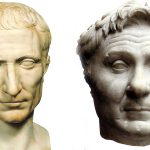Chapters
Every soldier going to battle had to be properly equipped. Over the centuries, the equipment of Roman legionaries changed really often. But it was really after Marius’ reform the Roman army took on significance. Perfectly trained, she also needed perfect equipment, which, together with a talented soldier, created an impassable barrier.
The legionary from the beginning of the republic differed significantly from his colleague, for example from the 2nd century CE. However, the changes mainly concerned the quality of individual elements, as well as the style of armament. The basic elements of armament have always been:
- helmet (galea)
- shield (scutum) first round, then rectangular; small officer’s shield (parma)
- armor – scale armor or chain mail (lorica hamata), later segment armor (lorica segmentata). Also used were: armour consisting of a caftan and rings riveted to it (lorica storta), armour with steel scales riveted to a leather caftan (lorica squamata), segmental arm protection (lorica manica) and a scale armour with very small tanks, intended for the command (lorica plumata)
- heavy spear (hasta) or javelins (pilum)
- a short, double-edged sword (gladius); long, also double-edged sword (spat (h) a) used by Roman cavalry
- sandals (caligae)
- cloak (sagum or sagulum) which was a rectangular piece of cloth, or paenula (a form of a Roman poncho with hood). The cloak was typical Gauls’ clothing and was adopted by the Roman army.
With the development of the military, the armament of the legionary was enriched with bows (arcus) and arrows (sagitae). Apart from them, there were also slings (fundae) and a crossbow (arcoballista), which were pulled on with a special device. Initially, they were used only by foreign troops, among which the Cretan archers and Balearic slingers were in the lead. Later, these weapons were used by auxiliary troops.
During Marius’s activity, greaves (ocreae) were introduced, worn on the right leg, which was originally only worn by hastati and principes. During the Empire, metal greaves were replaced with leather or woollen, reaching up to half of the calf. The feet were wrapped with straps up to the ankles.
The legionaries were additionally equipped with hoes (dolabra), shovel-pickaxes, and a crescent-shaped shovel to pick the turf, placed on the shaft. The Romans also had a device for marking out a grid of rectangles. It was called groma. Thanks to this device, they were able to accurately set the plan of the camp, on the basis of which they built it very quickly. Such an instrument was found during excavation work in Pompeii. The aquila eagle was always kept by the 1st Legion Cohort.
To make the legions as flexible as possible, as a result of Marius’ reform soldiers were ordered to wear bags (sarcinae) with cooking utensils (vasa), a sapper spatula and a few days’ supply of food (cibaria). The whole was complemented by parts of dismantled war machines.
Transformations of the Roman army
In the 3rd and 4th centuries CE, Roman units at the borders underwent a significant transformation that fundamentally changed the nature and appearance of the Roman imperial army. The Roman army increasingly used horses to face and repel numerous barbaric invasions. This was primarily due to the fact that the barbarians began to use cavalry more widely in their operations.
The presence of soldiers from outside of Rome in the ranks of the army led to the widespread use of Eastern and Germanic weapons, armour and methods of combat. It is worth mentioning here, among others about spiculum borrowed from the Germans – a javelin used in the late Roman army, which replaced the Roman pilum. The soldier also carried two of these weapons. In addition, the soldier had a 2 – 2.5 meter spear.
It should be noted, however, that Roman solutions were also used by barbarians, so the transformations in the army did not take place only in one direction.
The more common use of cavalry meant that gladius began to be replaced by a long, straight and double-edged sword called spatha,, used by both infantry and cavalry. Although the spatha was sharpened to inflict stab wounds, it was usually used for cuts; thanks to the longer blade there was a greater chance of reaching the rider on horseback. The Spatha was heavier than a gladius and was characterized by an educated and typical sword hilt of medium length, a thick and straight handguard, and a pommel which appeared to be a reduced form of a crossguard. Contrary to the gladius, adapted primarily to be used in a tight pedestrian formation under the cover of a large scutum shield, spatha it was better suited for riding and fighting in a looser formation (it did not exclude, however, a compact formation).
By the beginning of the 4th century, Roman infantry had almost completely abandoned the rectangular scutum shield. The protection of the Roman soldier began with a shield with a round, elliptical or, more rarely, oval shape, modelled on the Germanic style. The shield weighed over 3.5 kg. Among the armour, chain mail and scale armour were the most popular.
Interestingly, Vegetius (a late Roman writer) mentions in his work De re militari that Roman soldiers gave up wearing armour altogether; however, this is either a mistake of the author or information suggesting that the Romans had specially designated light units.










